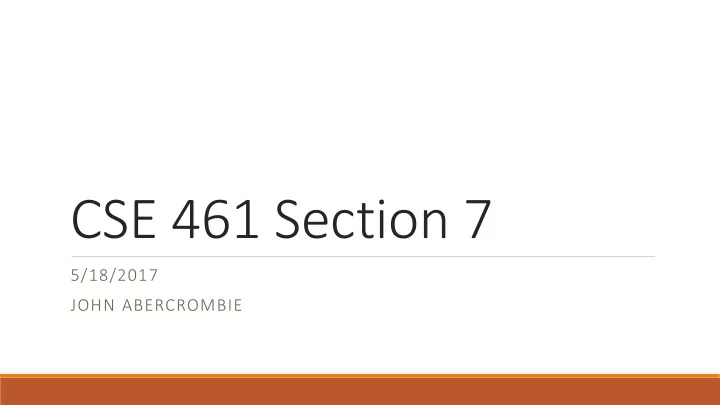

CSE 461 Section 7 5/18/2017 JOHN ABERCROMBIE
The interdomain routing problem Each AS determines its own routing policies ◦ One AS only wants to send and receive packets from the internet ◦ One AS can carry transit traffic for others if you pay this service Political considerations ◦ Never send traffic from the Pentagon on a route through Iraq Security considerations ◦ Traffic starting or ending at Apple should not transit Google Economic considerations ◦ Use cheaper service
Routing Policy Example Routing policy decides what traffic can flow over which links between ASes Provider, Customer, Peer
Terminology Autonomous system traffic • Local traffic: originates at or terminates on nodes within AS (intradomain routing) • Transit traffic: traffic that passes through an AS Types of Ases • Stub AS: has only one single connection to one other AS (local traffic only) • Multihomed AS: has connections to more than one other AS but refuses to carry transit traffic • Transit AS: connections to more than one other AS that is designed to carry both transit and local traffic
BGP Basics Types of routers: • Border router: packets enter and leave the AS • BGP Speaker: handles advertisements, usually the same as border routers Path-vector protocol • Not distance vector or link-state • AS Path: list of autonomous systems to reach a particular network • Built on TCP
BGP Route Advertisement Each BGP speaker prepends its own AS number to the route
Loop Detection Assign each AS a unique number ◦ BGP current version: 16 bits (is this enough?)
Route selection • Routes via peered networks are favored over routes via transit providers • Free! • Shorter AS paths are better • Prefer the route that has the lowest cost within the ISP • Only advertise routes that are good enough for you • Allow route withdrawal
One example Consider the following network with 6 Ases ◦ AS1 is the provider for AS2, AS3, and AS4 ◦ AS2 is the provider for AS5 ◦ AS3 is the provider for AS5 and AS6 ◦ AS5 and AS6 have a peer agreement
UDP User Datagram Protocol Single layer abstraction above direct host-to-host connection ◦ Allows process-to-process communication ◦ Each process on a given host needs to share a single network link Build application specific protocols on top
UDP Ports!
UDP Packets are buffered per port in a queue No flow-control No order guarantee No reliability mechanism Does provide checksum
TCP Tranmission Connection Protocol Supports multiple processes with ports (like UDP) Guarantees ◦ Reliability (every packet will be received) ◦ In order Flow control Two-way stream
TCP Requirements Connection establishment phase Adaptive retransmit Reordering packets Flow Control Network Congestion
More Protocols to Consider Remote Procedure Call (RPC) ◦ Largely in distributed systems Real-time Transport Protocol (RTP) ◦ Built on UDP ◦ Interactive applications ◦ Streaming applications
Recommend
More recommend